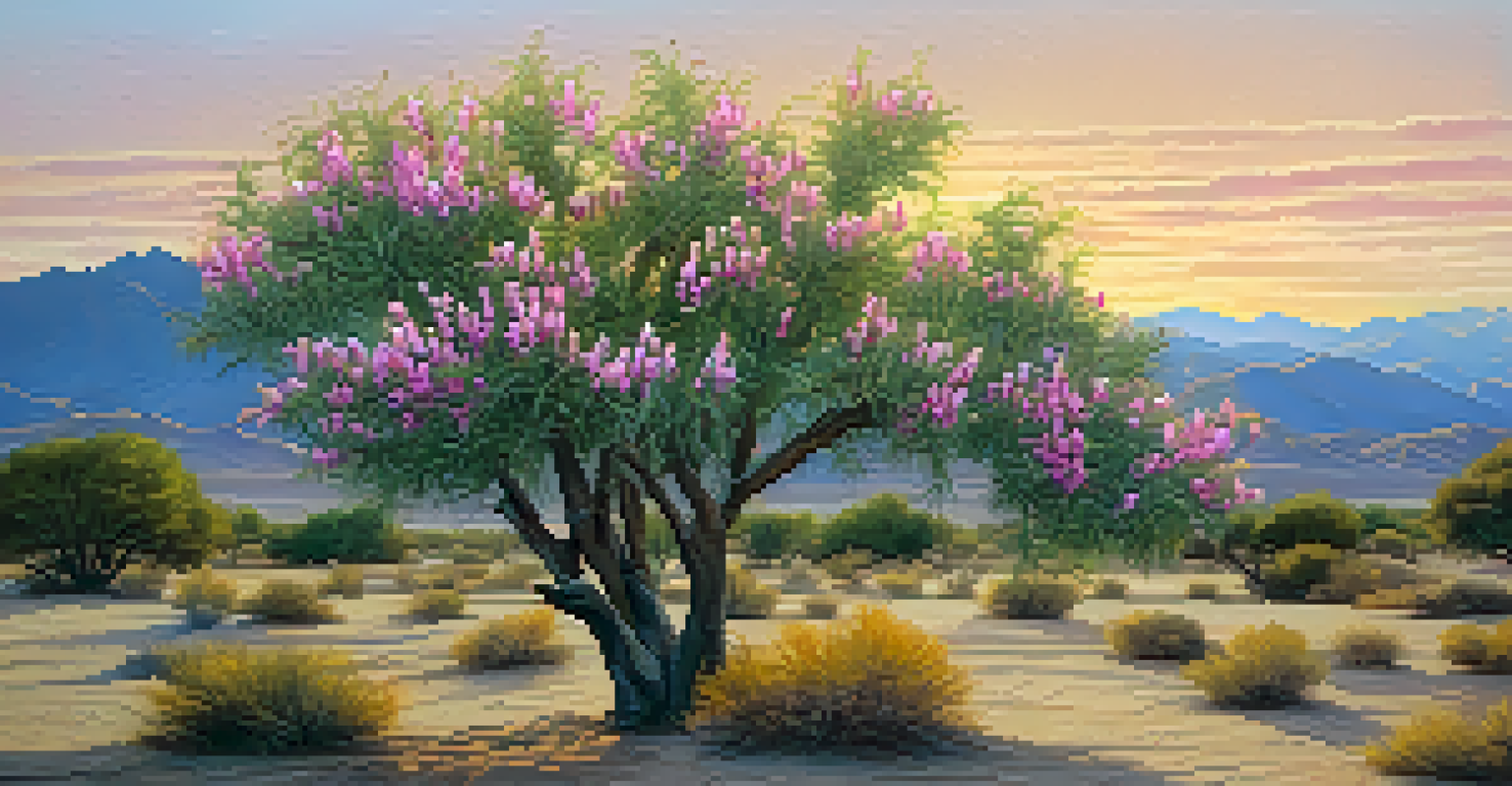Endemic Desert Plants: A Deep Dive into Palm Springs Flora

Understanding Endemic Plants and Their Importance
Endemic plants are species that grow naturally in a specific region and nowhere else. In the case of Palm Springs, the harsh desert environment has given rise to unique flora that thrives in these conditions. These plants play a crucial role in maintaining the local ecosystem, providing habitat and food for local wildlife.
The greatest threat to our planet is the belief that someone else will save it.
The significance of endemic plants extends beyond ecological balance; they also offer a glimpse into the evolutionary history of a region. Each species has adapted to the specific challenges of its environment, such as extreme temperatures and limited water availability. This adaptation process can take thousands of years, making these plants a living testament to nature's resilience.
By understanding endemic plants, we can appreciate biodiversity and the delicate relationships within ecosystems. Protecting these unique species is essential, as they are often vulnerable to habitat loss and climate change. Thus, recognizing their importance is the first step toward conservation efforts.
Diverse Climate and Geography of Palm Springs
Palm Springs is located in the Sonoran Desert, characterized by its arid climate and stunning landscapes. The region experiences hot summers and mild winters, creating challenging conditions for plant life. Despite this, the geographical diversity, from valleys to mountains, contributes to a variety of microclimates that support different plant species.

Elevation changes in the surrounding mountains also influence local weather patterns, providing some areas with slightly more moisture. This variation is crucial for the survival of many endemic plants that rely on specific conditions to thrive. For instance, certain species might flourish at lower elevations while others prefer the cooler, wetter conditions found higher up.
Endemic Plants: Ecosystem Essentials
Endemic plants are vital for local ecosystems, providing food and habitat while showcasing the region's evolutionary history.
Understanding the climate and geography of Palm Springs helps us appreciate the unique adaptations that endemic plants have developed. These adaptations are not just fascinating; they are vital for the sustainability of the local ecosystem. Each plant species is a key player in this intricate desert dance of life.
Iconic Endemic Plants of Palm Springs
Among the most recognizable plants in Palm Springs is the California Fan Palm, a striking feature of the desert landscape. This iconic palm can grow up to 60 feet tall and is often found near water sources, showcasing its adaptability. Its fan-shaped leaves provide shade and shelter, making it a vital resource for local wildlife.
In every walk with nature, one receives far more than he seeks.
Another notable endemic species is the Desert Willow, known for its stunning trumpet-shaped flowers. This plant not only adds beauty to the landscape but also attracts pollinators like bees and hummingbirds. Its ability to thrive in dry conditions makes it a popular choice for landscaping in the region, further blending nature with human development.
Lastly, the Creosote Bush is an essential component of the desert ecosystem, known for its resilience and strong scent after rainfall. This bush can live for decades and has numerous medicinal properties. Its ability to survive in harsh conditions makes it a symbol of desert endurance and adaptability.
Adaptations of Desert Plants to Harsh Conditions
Desert plants have developed remarkable adaptations to survive in extreme temperatures and scarce water. For instance, many have deep root systems that tap into underground moisture, allowing them to thrive even during long dry spells. This ability to access water deep within the soil is a crucial survival strategy.
Additionally, many desert plants have evolved to minimize water loss through unique leaf structures. Some have thick, waxy coatings that reduce evaporation, while others have tiny leaves or spines instead of traditional foliage. These adaptations are critical for conserving water, making it possible for them to live in such a dry environment.
Challenges from Human Impact
Urban development and tourism threaten endemic plant species in Palm Springs, highlighting the need for conservation efforts.
Furthermore, some species have developed a fascinating phenomenon called CAM (Crassulacean Acid Metabolism) photosynthesis. This process allows them to open their stomata at night, reducing water loss while still taking in carbon dioxide. These ingenious adaptations highlight the incredible resilience of desert flora.
Human Impact on Desert Flora and Conservation Efforts
Human activities have significantly impacted the delicate balance of desert ecosystems, including those in Palm Springs. Urban development, agriculture, and tourism have led to habitat loss and fragmentation, threatening endemic plant species. As more land is developed, the survival of these unique plants becomes increasingly precarious.
Conservation efforts are essential to protect and preserve the unique flora of Palm Springs. Local organizations and government initiatives work to promote sustainable practices and raise awareness about the importance of endemic plants. These efforts often include habitat restoration projects and educational programs aimed at fostering a deeper understanding of desert ecosystems.
By engaging the community and encouraging responsible tourism, we can help mitigate the impact of human activities on these fragile environments. Supporting local conservation initiatives allows us to play a part in protecting the extraordinary flora of Palm Springs for future generations.
Gardening with Endemic Plants in Palm Springs
Gardening with endemic plants is a fantastic way to support local ecosystems and enhance your outdoor space. When you choose native species, you're not only creating a beautiful landscape but also providing essential habitats for local wildlife. Many endemic plants are low-maintenance, making them an attractive option for homeowners.
For instance, incorporating the Desert Willow or California Fan Palm into your garden can provide shade and attract pollinators, turning your yard into a vibrant ecosystem. These plants are adapted to the local climate, requiring less water and care than non-native species, which can be a significant advantage in the arid desert environment.
Gardening with Native Species
Incorporating endemic plants into gardens supports local wildlife and preserves the unique heritage of the Palm Springs area.
Moreover, gardening with endemic plants helps preserve the unique heritage of the Palm Springs area. By choosing native flora, you're contributing to the conservation of these beautiful species, ensuring that they continue to thrive in their natural habitat. It's a win-win for both you and the environment!
The Future of Palm Springs Flora: Challenges and Opportunities
As climate change continues to alter weather patterns, the future of Palm Springs' endemic plants faces significant challenges. Rising temperatures and shifting rainfall patterns can stress these species, potentially leading to declines or even extinction. Understanding these challenges is crucial for developing strategies to protect the plants that define this unique ecosystem.
On the other hand, these challenges also present opportunities for innovation in conservation practices. Scientists and researchers are exploring ways to enhance the resilience of endemic plants, such as selective breeding for drought resistance. These efforts could help ensure that these plants endure in changing climates, preserving the rich biodiversity of the region.

Community engagement and education play vital roles in shaping the future of Palm Springs flora. By fostering a connection between residents and their local environment, we can inspire collective action toward conservation. Together, we can create a future where the beauty and diversity of Palm Springs' endemic plants continue to thrive.